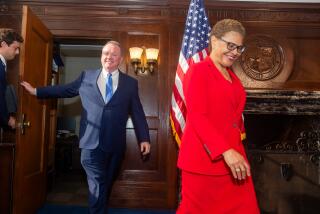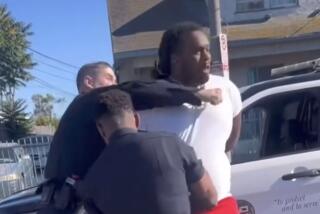LAPD’s ‘magic number’ of 10,000 officers losing some luster
- Share via
In 1989, then-Los Angeles Councilman Zev Yaroslavsky unveiled an audacious plan to boost the city police force by more than 25% to 10,000 officers.
He couldn’t have imagined that city leaders would chase that goal for nearly a quarter of a century until, at the start of this year, Mayor Antonio Villaraigosa announced that he had pushed the LAPD over the long-elusive benchmark.
The two candidates vying to replace Villaraigosa in the May 21 election — City Controller Wendy Greuel and Councilman Eric Garcetti — have embraced the mayor’s achievement, crediting the LAPD buildup in large measure for the city’s lowest crime rates since the 1950s. Indeed, Greuel has committed to enlarging the police force an additional 20%, if the city treasury grows.
Still lagging
Number of police officers per 1,000 population as of 2011:
| Washington, D.C. | 6.7 |
| New Orleans | 6.5 |
| Baltimore | 4.7 |
| Chicago | 4.7 |
| Philadelphia | 4.7 |
| Newark | 4.4 |
| New York | 4.3 |
| St. Louis | 3.9 |
| Boston | 3.7 |
| Cleveland | 3.6 |
| Detroit | 3.5 |
| Atlanta | 3.4 |
| Milwaukee | 3.4 |
| Cincinnati | 3.2 |
| Los Angeles | 2.5 |
| Houston | 2.3 |
| Phoenix | 2.1 |
| Albuquerque | 1.9 |
| Las Vegas | 1.8 |
| San Diego | 1.5 |
Source: FBI
But increasingly, voices on the periphery of the mayoral campaign argue that rising police costs — up 36% to more than $2 billion over the last eight years, more than twice the rate of growth in such discretionary spending overall — raises two critical questions: Has the expansion been crucial to making Los Angeles safer? Has the relentless pursuit of more officers come at too great a cost to paramedic response times, paving streets and other basic services?
Among those raising such concerns are former police chief and current Councilman Bernard C. Parks, Councilman Paul Koretz, former first deputy mayor and businessman Austin Beutner, the police officers’ union and, in a small irony, Yaroslavsky.
“If the Police Department does not lose any officers over the next few years, during this time of economic hardship, it’s because the rest of city services have been eviscerated,” said Yaroslavsky, now a Westside and San Fernando Valley representative on the county Board of Supervisors. “I don’t think it’s sensible to say that we cannot cut the Police Department by even one position.”
There is little consensus among criminal-justice academics about the effect that changes in police staffing have on crime rates. Where officers are deployed and the assignments they are given appear to be as important as the number of cops on the payroll, said Jeremy M. Wilson, a Michigan State University criminologist. A recent report on police staffing levels coauthored by Wilson suggested that many departments simply guess the number of officers needed. “We determine how many officers we need,” said one police official in the report, “by holding an envelope to our head.”
Many criminologists who have studied big-city crime decreases credit longer prison sentences and the retreat of the crack-cocaine epidemic, among other reasons, as being most responsible for bringing down crime. They point to cities such as Seattle and Dallas that cut police staffing in the 1990s and still saw crime drop sharply.
But LAPD Chief Charlie Beck argues that there is an important correlation between officer staffing levels and lower crime rates. Cities such as San Jose, Long Beach and Oakland saw crime surge after cutting their police forces, he said.
Villaraigosa, whose legacy is tied to his record of expanding the Police Department, despite the Great Recession, also draws a direct line between more cops and less crime. The city has had fewer than 300 murders each of the last three years, he notes, down from a high of nearly 1,100 in 1992.
“The numbers speak for themselves,” Villaraigosa said. “A 49% drop in violent crime and homicides, a 66% drop in gang homicides. Growing our Police Department and ... community policing is a big reason why we are safer today.”
But why 10,000 cops for L.A.?
Yaroslavsky latched onto the number after crack- and gang-fueled violent crime surged. Voters demanded action. The 10,000 figure lacked any analytical underpinning but was “a nice round number,” Yaroslavsky chuckled in an interview. It also “takes the force from four digits to five digits.” The goal stuck, becoming a lodestar of L.A.’s mayoral politics ever since.
Police Chief Willie L. Williams, hired three years after Yaroslavsky rolled out his plan, said he wanted to reach the mark by 2000. In 1993, mayoral candidate Richard Riordan suggested pushing the force past 10,000 officers by leasing Los Angeles International Airport to a private operator and diverting the income to the LAPD. His opponent, Councilman Michael Woo, pledged to reach the 10,000-officer target by shifting money away from other departments. Riordan won the contest but never added the 3,000 officers he had promised.
In 2005, mayoral contender Villaraigosa pledged 1,000 additional officers, which would have brought the LAPD to a force of 10,200.
To finally claw past the 10,000-cop threshold, his administration employed a bureaucratic sleight of hand — shifting 60 officers to the LAPD from the General Services Department, which patrols parks, libraries and other municipal buildings. The result: no net increase in officers, but effectively 10,000 wearing LAPD blue. (Due to routine fluctuations in staffing, the figure dipped to 9,976 last week.)
The department’s highest-ever staffing comes with a notable asterisk. Because the city has all but eliminated funding for police overtime, cops must instead be compensated with time off, removing the equivalent of 400 or more officers from duty. That effectively reduces Villaraigosa’s police buildup during his eight years in office by at least half, according to Beutner, the mayor’s former first deputy.
Using the 10,000-officer figure, the LAPD now employs more than 2.5 officers per 1,000 residents. That’s low compared to Chicago (4.7) and New York (4.3) but higher than other large western cities such as Houston (2.3), Phoenix (2.1) and San Diego (1.5). Criminologists warn that such ratios can be misleading because so many other factors — including geography and deployment patterns — are more important factors.
The LAPD, including the cost of benefits to retired officers, now consumes more than 55% of the $4 billion in revenue that city officials have discretion over, compared with 46% nine years ago.
The increased expenditures are worth it, Beck says, because public safety is the city’s No. 1 priority. Current staffing is the “absolute minimum” needed to keep the city safe, he argues.
Others say it’s time to reconsider the trade-offs.
The city attorney’s prosecutorial staff has declined from 300 to 200 attorneys over the last four years. Street repair and maintenance spending this year was 36% lower than when Villaraigosa took office. The Fire Department lost units at one-fifth of the city’s stations in 2011, exacerbating increases in 911 response times to medical emergencies.
Both the city attorney and fire rescue operations “have been hacked to pieces,” said Councilman Koretz. “Why should every other city department be pushed to the point where they can barely do their job when the LAPD is doing great? I don’t think a modest decrease in their numbers will make that big a difference.”
On that point, Koretz, a committed liberal, has become an unlikely ally with Parks, the council’s leading budget hawk. The former police chief has tried, and failed, to get a majority of his council colleagues to consider allowing LAPD staffing to decline slightly.
Beutner, a one-time mayoral hopeful who raised concerns about paramedic response times, says a thorough review of police staffing is needed. “They should be looking at all the resources and factors,” he said, “instead of just picking this one nice, round political-sounding number and assuming it’s the right answer.”
The Police Protective League, the union representing rank-and-file officers, has said the 10,000-officer goal was “pulled out of the air for political reasons.” More effective staffing could be accomplished by fully funding overtime for current officers and hiring more civilians to free up cops filling desk jobs, the union says.
Beck disagrees strongly. Hiring more civilians at the expense of cops, he says, would not free up enough officers to make a significant difference. He added that it’s far cheaper to sustain the current force — at the cost of about $10 million a year to fill vacant positions — than to fully fund overtime for $80 million a year. And a freeze on police hiring would mean losing momentum on crime-fighting gains, the chief said.
“For the past three years I have delivered unparalleled crime reductions while sticking to the worst budgets in decades,” Beck said. “Why would anyone doubt what I say about how to best use the resources of the LAPD?”
Yaroslavsky suggested that a 500-officer reduction would save $75 million a year, enough to restore money for pothole repairs, removing dead animals, cleaning up graffiti and the like. The LAPD would still be the city’s top spending priority, he said.
“The next mayor, I think, is going to have to be a little more open to putting all departments on the table when it comes to the budget,” he said. “The LAPD is very good. But you can’t tell me it can’t find a way to help mitigate the crisis caused by the worst recession we have seen, at a time when crime rates are as low as they have been since the Eisenhower administration.”
Beck said he could imagine a time when other city agencies have been so diminished that it would not be wise to protect police hiring. But he added: “I don’t see us being anywhere close” to that point.
Villaraigosa agreed. “In a city that is still the gang capital of the United States of America, in a city where less than 20 years ago we were the most violent city in America, it’s not worth taking a chance.”
More to Read
Sign up for Essential California
The most important California stories and recommendations in your inbox every morning.
You may occasionally receive promotional content from the Los Angeles Times.












